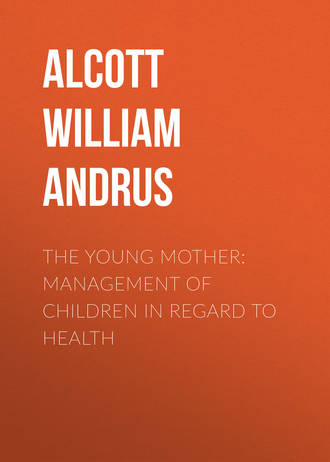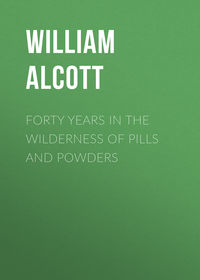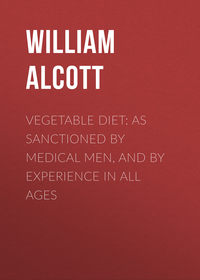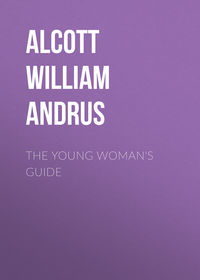 полная версия
полная версияThe Young Mother: Management of Children in Regard to Health
Those with whom no arguments will avail, are recommended to read the following remarks from the first volume of the Library of Health, p. 119:
"It is related, on the authority of Macgill, that in Tunis, after a girl is engaged, or betrothed, she is then fattened. For this purpose, she is cooped up in a small room, and shackles of gold and silver are placed upon her ancles and wrists, as a piece of dress. If she is to be married to a man who has discharged, despatched, or lost a former wife, the shackles which the former wife wore are put on the new bride's limbs, and she is fed till they are filled up to a proper thickness. The food used for this custom worthy of the barbarians is called drough, which is of an extraordinary fattening quality, and also famous for rendering the milk of the nurse rich and abundant. With this and their national dish, cuscasoo, the bride is literally crammed, and many actually die under the spoon."
We laugh at all this, and well we may; but there are customs not very far from home, no less ridiculous.
"There is a country four or five thousand miles westward of Tunis, where the females, to a very great extent, are emaciated for marriage, instead being fattened. This process is begun, in part, by shackles—not of gold and silver, perhaps, but of wood—but instead of being put on loosely, and causing the body or limbs to fill them, they are made to compress the body in the outset; and as the size of the latter diminishes, the shackles are contracted or tightened. As with the eastern, so with the western females, many of them die under the process; though a far greater number die at a remote period, as the consequence of it."
SEC. 3. MaterialI have already committed myself to the reader as favoring the use of soft flannel in cold weather, especially for children who are not yet able to run about freely in the open air. The advantages of an early use of this material, at least for under-clothes, are numerous. The following are a few of them.
1. Flannel, next to the skin, is a pleasant flesh brush; keeping up a gentle and equable irritation, and promoting perspiration and every other function which it is the office of the skin to perform, or assist in performing.
2. It guards the body against the cooling effects of evaporation, when in a state of profuse perspiration.
3. By preventing the heat of the body from escaping too rapidly, it keeps up a steadier temperature on the surface than any other known substance. The importance of the last consideration is greater, in a climate like our own, than elsewhere.
But there are limits to the use of this article of clothing. Whenever the temperature of the atmosphere is so great, even without artificial heat, that we no longer wish to retain the heat of the body by the clothing, then all flannel should be removed at once, and linen should be substituted; taking care to replace the flannel whenever the temperature of the atmosphere, as indicated by the thermometer, or by the child's feelings, may seem to require it.
It should also be kept clean. There is a very general mistake abroad on this subject. Many suppose that flannel can be worn longer without washing than other kinds of cloth. On the contrary, it should be changed oftener than cotton, or even linen, because it will absorb a great deal of fluid, especially the matter of perspiration, which, if long retained, is believed to ferment, and produce unhealthy, if not poisonous gases. For this reason, too, flannel for children's clothing should be white, that it may show dirt the more readily, and obtain the more frequent washing; although it is for this very reason—its liability to exhibit the least particles of dirt—that it is commonly rejected.
One caution more in regard to the use of flannel may be necessary. With some children, owing to a peculiarity of constitution, flannel will produce eruptions on the skin, which are very troublesome. Whenever this is the case, the flannel should be immediately laid aside; upon which the eruptions usually disappear.
If parents would take proper pains to get the lighter, softer kinds of flannel for this purpose, and be particular about its looseness and quantity, I should prefer, as I have already intimated, to have very young children, in our climate, wear this material the greater part of the year, excepting perhaps July and August.
My reasons for this course would be, first, that I like the stimulus of soft flannel on the skin, if changed sufficiently often, better than that of any other kind of clothing. Secondly, cotton is so liable to take fire, that its use in the nursery and among little children seems very hazardous. Thirdly, silk is not quite the appropriate material, as a general thing, besides being too expensive; and fourthly, linen is not warm enough, except in mid-summer.
Except, therefore, in July and August, and in cases of idiosyncracy, such as have just been alluded to, I would use flannel for the under-clothes of young children, throughout the year. But whenever they acquire sufficient strength to walk and run, and play much in the open air, I would gradually lay aside the use of all flannel, even in winter. Great attention, however, must be paid to the quantity. The parent who, guided by this rule, should keep on her child the same amount of flannel, and of the same thickness, from January to June 30th, and then, on the first of July, should suddenly exchange it for thin linen, in moderate quantity, might find trouble from it. It is better to make the changes more gradually; otherwise, whatever may be the material of the dress, the child will be likely to suffer.
SEC. 4. QuantityThe quantity of clothing used by different individuals of the same age, in the same climate, possessing constitutions nearly alike, and following similar occupations, is so different as to strike us with surprise when we first observe the fact.
One will wear nothing but a coarse linen or cotton shirt, coarse coat, waistcoat, and pantaloons, and boots, in the coldest weather. He never, unless it be on the Sabbath, puts on even a cravat, and never in any case stockings or mittens.
Another, in similar circumstances in all respects, constantly wears his thick stockings, flannel wrapper and drawers, and cravat; and seldom goes out, in cold weather, without mittens and an overcoat. He is not a whit warmer: indeed he often suffers more from the cold, than his neighbor who dresses in the manner just described.
Why all this difference? It is no doubt the result of habit. Any individual may accustom himself to much or little clothing. And the earlier the habit is begun, the greater is its influence.
Some persons, observing how little clothing one may accustom himself to use and yet be comfortable, have told us, that so far as mere temperature is concerned, we need no clothing at all. They relate the story of the Scythian and Alexander. Alexander asked the former how he could go without clothes in such a cold climate. He replied, by asking Alexander how he could go with his face naked. "Habit reconciles us to this;" was the reply. "Think me, then, all face," said the Scythian.
But admitting that certain individuals, and even a few rude tribes, have gone without clothing; did they therefore follow, in this respect, the intentions of nature? The greatest stickler for adhering to nature's plan, cannot prove this. Analogy is against it. Most of the other animals, even in hot climates, are furnished with a hairy covering from the first; and in cold climates, the Author of their being has even provided them with an increase of clothing for the winter. Their fur, on the approach of cold weather, not only becomes whiter, and therefore conducts the heat away from the body more slowly, but, as every dealer in furs well understands, it becomes softer and thicker. And yet the blood of the furred animals of cold countries is as warm as ours, if not warmer.
The inferences which it seems to me we ought to make from this are, that if other animals require clothing, and even a change of clothing, so does man; and that as the Creator has left him to provide, by his own ingenuity, for a great many of his wants, instead of furnishing him with instinct to direct him, so in relation to dress. And even if it could be proved that dress were naturally unnecessary, with reference to temperature, I should still defend its use on other principles. The few speculative minds, therefore, that in the vagaries of their fancy, but never in their practice, reject it, are not to be regarded.
The principle laid down in the commencement of the chapter on Temperature, is the great principle which should guide us in regard to dress. But although we should always keep a little too cool rather than a little too warm, it is by no means desirable to be cold. Any degree of chilliness, long continued, interrupts the functions which the skin ought to perform, and thus produces mischief.
The same rules, in this respect, apply to eating, as well as to dress. It is better to eat a little less than nature requires, than a little more. It is a generally received opinion, however, that mankind frequently, at least in this country, eat about twice as much as health requires. This is owing to habit; and perhaps the power of the latter is as great in this respect as in regard to dress.
The great point in regard to food or dress is, to begin right, and, observing what nature requires—studying at the same time the testimony of others—to endeavor to keep within the bounds she has assigned. It has already been more than intimated, that if the nursery be kept in a proper temperature, a single loose piece of dress is, for some time, all that is required. In pursuance of this principle, through life, I believe few persons would be found who would need more at one time than a single suit of woollen clothes, even in the severest winters of our northern climate.
I have always observed that they who wear the greatest amount of clothing, are most subject to colds. There are obvious reasons why it should be so. This, then, if a fact, is one of the strongest reasons in favor of acquiring a habit of going as thinly clad as we possibly can, and not at the same time feel any inconvenience.
But after all, whether it be winter or summer, we must vary our clothing with the variations of the weather, as indicated by the thermometer, and our own feelings. Sometimes, in our ever-changing and ever-changeable climate, it may be necessary to vary our dress three or four times a day. Some cry out against this practice as dangerous, but I have never found it so. I have known persons who made it a constant practice; and I never found that they sustained any injury from it, except the loss of a little time; and the increase of comfort was more than enough to compensate for that. There is one thing to be avoided, however, whether we change our clothing—our linen especially—twice a day, or only twice a week—which is, dampness.
SEC. 5. CapsThe practice of putting caps on infants is happily going by; and perhaps it may be thought unnecessary for me to dwell a single moment on the subject. But as the practice still prevails in some parts of the country, it may be well to bestow upon it a few passing remarks.
Many mothers have not considered that the circulation of the blood in young infants is peculiarly active; that a large amount of blood is at that period carried to the head; that in consequence of this, the head is proportionably hotter than in adults; and that from this source arises the tendency of very young children to brain-fever, dropsy in the head, and other diseases of this part of the system. But these are most undoubted facts.
Hence one reason why the heads of infants should be kept as cool as possible; and though a thin cap confines less heat than a thick head of hair does when they are older, yet they are less able to bear it. The truth is, that nature furnishes a covering for the head, just about as fast as a covering is required, and the child's safety will permit.
At the present day, few persons will probably be found, who will defend the utility of caps, any longer than till the hair is grown. The general apology for their use after this period, and indeed in most instances before, is, that they look pretty. "What would people say to see my darling without a cap?"
But when the head is kept, from the first, totally uncovered, the hair grows more rapidly, dandruff and other scurfy diseases rarely attack the scalp; catarrh, snuffles, and other similar complaints, and above all, dropsy in the head, seldom show themselves; and the period of cutting teeth, that most dangerous period in the life of an infant, is passed over with much more safety.
"Nothing but custom," says a foreign writer, "can reconcile us to the cap, with all its lace and trumpery ornaments, on the beautiful head of a child; and I would ask any one to say candidly, whether he thinks the children in the pictures of Titian and Raffaelle would be improved by having their heads covered with caps, instead of the silken curls—the adornment of nature—which cluster round their smiling faces. If there were no other reason for disusing caps for infants, but the improvement which it produces in the appearance of the child, I would maintain that this is a sufficient inducement." And I concur with him fully.
As to the notion—now I hope nearly exploded—that it is necessary to cover up the "open of the head," as it is called, nothing can be more idle. This part of the head requires no more covering than any other part; and if it did, all the dress in the world could not affect it in the least, except to retard the growth of the bones, which, in due time, ought to close up the space; and this effect, anything which keeps the head too hot might help to produce. Of the folly of wetting the head with spirits, or any other medicated lotions, and of making daily efforts to bring it into shape, it is unnecessary to speak in the present chapter.
SEC. 6. Hats and BonnetsThe hats worn in this country are almost universally too warm. But if it is a great mistake in adults to wear thick, heavy hats, it is much more so in the case of children.
The infant in the nursery, as we have already seen, needs no covering of the kind. It is absolutely necessary that the head should be kept as cool as possible; and absolutely dangerous to cover it too warmly. At a later period, however, the danger greatly diminishes, because the circulation of the blood becomes more equal, and does not tend so much towards the brain.
Still, however, the head is hotter than the limbs, especially the hands and feet; and I cannot help thinking that the hair is the only covering which is perfectly safe, either in childhood or age; except in the sunshine or in the storm. There may be—there probably is—some danger in going without hat or bonnet in the hot sun; though I have known many children, and some grown persons, who were constantly exposed in this way, and yet appeared not to suffer from it.
But this may be the proper place to state that we are ever in great danger of deceiving ourselves on this subject. If the individuals who follow practices usually regarded as pernicious, while their habits in other respects are just like those of other persons around them who have similar strength, &c. of constitution,—if these individuals, I say, were wholly to escape disease, through life, or if they were to be so much more free from it, and live to an age so much greater than others as to constitute a striking and obvious difference in their favor, we might then safely argue that the practices which they follow are at least without dangers, if not of obvious advantage. But when we see them beset with ills, like other people, it is not safe to pronounce their habits favorable to health, since it is impossible to know whether some of the ills which they suffer are not produced by them.
These remarks are applicable to the disuse of any covering for the head in the sun and in the rain. For you will find those who adopt this practice from early infancy,2 subject to as many diseases as those around them with similar constitutions, but with habits somewhat different; and as our diseases are generally the consequences of our errors in one way or another, it is impossible to say with certainty that some of them might not have arisen from exposure of the head.
I should not hesitate, therefore, to advise all mothers to put a light hat or bonnet on the heads of their children, whenever they are to be exposed to the direct rays of the summer sun, or to the rain. And as we cannot always foresee when and where these exposures will arise, and as it is believed that these coverings, if light, will never be productive of much injury while we are abroad in the open air, it will follow that it is better to wear than to omit them.
But while I contend for their use as consistent with health and sound philosophy, I must not be understood as admitting the use of such hats as are worn at present, even by children. They are, as I have said before, too hot. What should be substituted, I am unable to determine; but until something can be supplied, which would not be half so oppressive as our common wool hats, I should regard it as the lesser evil to omit them entirely. The danger of going bare-headed, if the practice is commenced early, we know from the customs of some savage nations, can never be very great.
SEC. 7. Covering for the FeetThe same reason for avoiding the use of any covering for the head, in early infancy, is a sufficient reason for covering the feet well. For just in proportion as the blood is sent to the head in superabundance, and keeps up in it an undue degree of heat, just in the same proportion is it sent to the feet in too small a quantity, leaving these parts liable to cold. Now it is a fundamental law with medical men, that the feet ought to be kept warmer than the head, if possible; especially while the child is very young, and exposed to brain diseases.
So long, therefore, as children are young, and unable to exercise their feet, stockings ought to be used, both in summer and winter; but I prefer to have them short, unless long ones can be used without garters. Everything in the shape of a garter or ligature round the limbs, body, or neck of a child, except a single body-band, already mentioned in another chapter, ought forever to be banished.
It has often been objected, I know, that stockings will make the feet tender. But as no child was ever hardened by continued and severe cold applied to any part of the body, but the contrary, so no one was ever made more tender by being kept moderately warm. Excess of heat, like excess of cold, will alike weaken either children or adults; but there is little danger of heating the feet and legs of infants too much during the first year of infancy.
It is also said that stockings are apt to receive and retain wet. But as I shall show in another place that wet clothes should be frequently changed, this objection would be equally strong against wearing coats and diapers.
As to shoes, there is some variety of opinion among medical men. A few hold that they cramp the feet, and prevent children from learning to walk as early as they otherwise would. If it were best for children that they should learn to walk as early as possible, the last objection might have weight. But it seems to me not at all desirable to be in haste about their walking. Indeed, I greatly prefer to retard their progress, in this respect, rather than to hasten it.
As to the first objection, that shoes cramp the feet too much, nearly its whole force turns upon the question whether they are made of proper materials or not. There is no need of making them of cow-hide, or any other thick leather. The soles are the most important part. These will defend the feet against pins, needles, and such other sharp substances as are usually found on the floor; and the upper part of the shoe, so long as the wearer remains in the nursery, may be made of the softest and most yielding material—even of cloth. Infants' shoes should always be made on two lasts, one for each foot.
The philosopher Locke held, that in order to harden the young, their shoes ought to be "so that they might leak and let in water, whenever they came near it." There may be and probably is, no harm in having a child wet his feet occasionally, provided he is soon supplied with dry stockings again; but it is hazardous for either children or adults to go too long in wet stockings, and especially to sit long in them, after they have been using much active exercise. I am in favor of good, substantial shoes and stockings for people of all ages and conditions, and at all seasons; and believe it entirely in accordance with sound economy and the laws of the human constitution.
SEC. 8. PinsThe custom of using ten or a dozen pins in the dressing of children, ought by all means to be set aside. They not only often wound the skin, but they have occasionally been known to penetrate the body and the joints of the limbs. So many of these dreadful accidents occur, and where no accident happens, so much pain is occasionally given by their sharp points to the little sufferer, who cannot tell what the matter is, that it is quite time the practice were abolished.
Do you ask what can be substituted?—The following mode is adopted by Dr. Dewees in his own family, as mentioned in his work on the "Physical and Medical Treatment of Children," at page 86.
"The belly-band and the petticoat have strings; and not a single pin is used in their adjustment. The little shirt, which is always made much larger than the infant's body, is folded on the back and bosom, and these folds kept in their places by properly adjusting the body of the petticoat: so far not a pin is used. The diaper requires one, but this should be of a large size, and made to serve the double purpose of holding the folds of this article, as well as keeping the belly-band in its proper place; the latter having a small tag of double linen depending from its lower margin, by which it is secured to the diaper, by the same pin.
"Should an extraordinary display of best 'bib and tucker' be required upon any special occasion, a third pin may be admitted to ensure the well-sitting of the 'frock' waist in front;—this last pin, however, is applied externally; so that the risk of its getting into the child's body is very small, even if it should become displaced."
The writer from whom the last two paragraphs are taken, says be has seen needles substituted for pins; and relates a long story of a child whose life was well nigh destroyed in this manner. It underwent months of ill health, and many moments of excruciating agony, before the cause of its trouble was suspected. Sometimes its distress was so great that nothing but large doses of laudanum, sufficient to stupify it, could afford the least relief. At last a tumor was discovered by the attending physician, near one of the bones on which we sit, and a needle was extracted two inches long. The needle had been put in its clothes, and, by slipping into the folds of the skin, had insinuated itself, unperceived, into the child's body. It is pleasing to add, that, although the little sufferer had now been ill seven or eight months, and had endured almost everything but death,—fever, diarrhoea, and the most excruciating pain,—it soon recovered.
This shocking circumstance is enough, one would think, to deter every mother or nurse, who becomes acquainted with it, from using needles in infants' clothes. Happy would it be, if, in banishing needles, they would contrive to banish pins also, and adopt either the plan of Dr. Dewees, or one still more rational.
SEC. 9. Remaining WetOn the subject of changing the wet clothing of a child, there is a strange and monstrous error abroad; which is, that by suffering them to remain wet and cold, we harden the constitution. The filthiness of this practice is enough to condemn it, were there nothing else to be said against it.
It is insisted on by many, I know, that as water which is salt, when it is applied to the skin, and suffered to remain long, while it secures the point of hardening the child, prevents all possibility of its taking cold, it hence follows, that wet diapers are not injurious. But this is a mistake. Every time an infant is allowed to remain wet, we not only endanger its taking cold, but expose it to excoriations of the skin, if not to serious and dangerous inflammation. In short, if frequent changes are not made, whatever some mothers and nurses may think, they may rest assured, that the health of the child must sooner or later suffer as the consequence.





